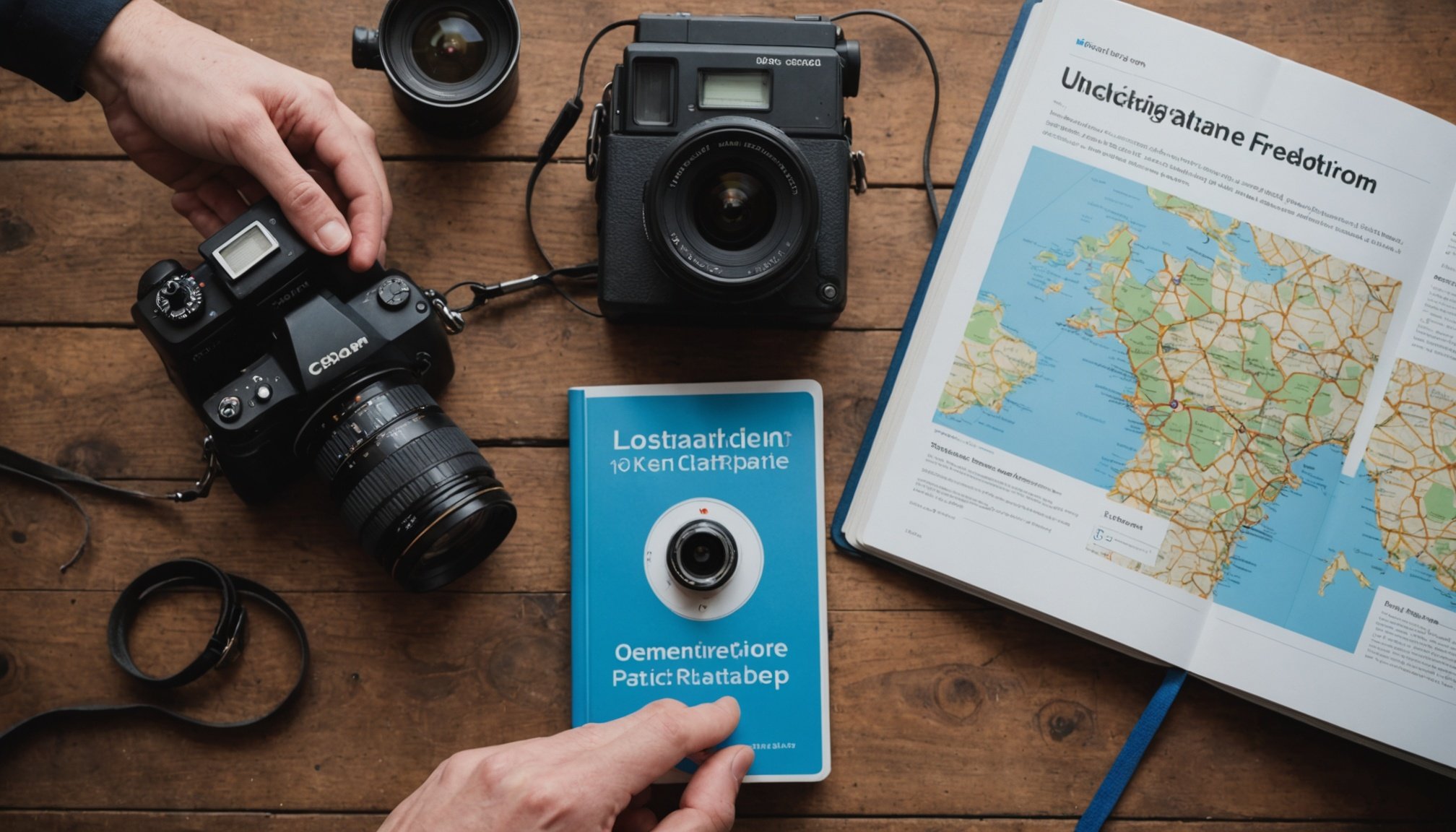Unlocking Location Freedom: Your Comprehensive Handbook for UK Film Shoot Permits
Understanding the Basics of Film Shoot Permits in the UK
When it comes to filming in the UK, whether you are a seasoned professional or a young filmmaker, understanding the permit process is crucial for a smooth and successful production. The UK, with its rich history, diverse landscapes, and vibrant cities, offers a plethora of locations that can bring your film to life. However, each location comes with its own set of rules and regulations.
Public vs. Private Property
One of the first things to consider is whether you are filming on public or private property. In the UK, filming in public places generally does not require a permit, but there are exceptions. For instance, if you are filming in areas like Trafalgar Square or Parliament Square in London, you will need written permission from the Mayor or the relevant authorities[1].
Also to see : Kickstarting Your UK Tech Venture: An All-Inclusive Handbook on Innovation and Government Funding
On private property, you need to obtain permission from the landowner. This can include conditions or restrictions on photography, but the landowner cannot inspect or delete your photographs unless you breach these conditions[1].
Obtaining Permits for Commercial Filming
Commercial filming, which involves financial gain or the promotion of goods and services, requires more stringent permissions.
This might interest you : Comprehensive blueprint for uk craft breweries: a step-by-step journey through food and beverage labeling regulations
Steps to Obtain a Permit
To film commercially in the UK, you typically need to follow these steps:
- Identify the Location: Decide on the best location for your shoot. If it’s on private land, you’ll need to identify the landowner and obtain their permission[3].
- Contact Local Authorities: For public spaces, you’ll often need to contact the local film office or council. For example, in Somerset, you need to complete the Application to Film form and pay the relevant fees[2].
- Submit Necessary Documents: You will typically need to submit a Student Filming Application form, a copy of your Public Liability Insurance, a Risk Assessment, and a method statement outlining your plans and safety measures[3].
Here is a detailed list of what you might need:
- Application Form: Specific to the location, such as the Student Filming Application form in Essex[3].
- Public Liability Insurance: A valid certificate is often required, especially for commercial shoots[2][3].
- Risk Assessment: A detailed assessment of the potential risks and how you plan to mitigate them[3].
- Method Statement: An outline of what you intend to do on site and how you will do it safely[3].
Fees and Charges
Fees for filming permits can vary widely depending on the location and the size of your crew. Here is a comparative table of fees for filming in Somerset:
| Crew Size | More than 5 Working Days Notice | Less than 5 Working Days Notice |
|---|---|---|
| 1 to 10 | £50 | £75 |
| More than 10 | £75 | £100 |
For general views, the fees are as follows:
| Crew Size | Half Day (up to 5 hours) | Full Day (up to 8 hours) |
|---|---|---|
| Any crew size | £50 | £100 |
For drone filming, the fees are:
| Crew Size | Half Day (up to 5 hours) | Full Day (up to 8 hours) |
|---|---|---|
| Any crew size | £100 | £150 |
And for using council land and property:
| Crew Size | Half Day (up to 4 hours) | Full Day |
|---|---|---|
| Small (up to 10 people) | £250 | £500 |
| Medium (11 to 40 people) | £350 | £700 |
| Large (over 40 people) | £500 | £1000 |
Ensuring Safety and Compliance
Safety and compliance are paramount when filming, especially in public spaces.
Risk Assessments and Method Statements
A thorough risk assessment is essential to identify potential hazards and outline how you will mitigate them. This includes considering factors such as obstructions, trip hazards, and the impact on day-to-day activities in the filming location[4].
Here are some key points to include in your risk assessment:
- Health and Safety Impact: Consider how your filming will affect the health and safety of those in the vicinity.
- Emergency Procedures: Ensure that your filming does not interfere with emergency procedures such as fire detection or escape routes.
- General Infection Control: Follow guidelines for infection control, especially in shared spaces.
- Notification: Notify security and other relevant parties about your filming plans to avoid any disruptions[4].
Code of Conduct
Adhering to a code of conduct is crucial for maintaining professional standards and ensuring the smooth execution of your film shoot.
- Respect for Locations: Make sure to leave the location in the same condition as you found it.
- Respect for People: Obtain permission from individuals who are not directly involved in the filming.
- Compliance with Regulations: Always comply with local regulations and guidelines provided by the authorities[4].
Case Study: Filming in Somerset
To illustrate the process, let’s consider a case study of filming in Somerset.
Planning Your Shoot
If you plan to film in Somerset, you need to start by reading the relevant guidelines and codes of practice. Here’s a step-by-step guide:
- Application: Complete the Application to Film form available on Screen Somerset.
- Documentation: Ensure you have all necessary documents, including Public Liability Insurance and a Risk Assessment.
- Fees: Pay the applicable fees based on your crew size and the duration of your shoot[2].
Example of a Successful Shoot
A young filmmaker, Sarah, wanted to shoot a short film in the picturesque town of Glastonbury in Somerset. She followed the guidelines meticulously:
- Permission: She obtained permission from the landowners and local authorities.
- Risk Assessment: She conducted a thorough risk assessment to ensure safety.
- Notification: She notified the local residents and businesses about her filming plans.
Sarah’s attention to detail and compliance with regulations ensured that her shoot was successful and hassle-free.
Cutting-Edge Technology and Environmental Considerations
In today’s world, technology and environmental considerations play a significant role in film production.
Hydrogen and Carbon Footprint
As the film industry moves towards more sustainable practices, considering the carbon footprint of your production is essential. Here are some tips to reduce your carbon footprint:
- Use Eco-Friendly Equipment: Opt for equipment that uses hydrogen or gas electricity, which can be more environmentally friendly.
- Minimize Travel: Plan your locations to minimize travel, reducing the need for gas electricity and other carbon-intensive resources.
- Sustainable Practices: Adopt sustainable practices in your production, such as using reusable materials and minimizing waste[4].
Supporting Young People in Film
The UK film industry is keen to support young people in developing their skills and creativity.
Educational Resources
Many universities and film offices offer resources and support for young filmmakers. For example, the University of Hertfordshire has specific guidelines and forms for students who want to film on campus[4].
Here are some tips for young people looking to get into film:
- Seek Guidance: Contact your tutor or the film office for guidance on the permit process.
- Practice Safety: Always conduct a thorough risk assessment and follow safety guidelines.
- Develop Your Skills: Take advantage of educational resources and workshops to develop your filmmaking skills.
Fine Art and Filming in Public Spaces
Filming in public spaces can be a great way to capture high-quality footage, but it requires careful planning.
Freedom of Panorama
In the UK, the Copyright, Designs and Patents Act 1988 provides a freedom of panorama clause, allowing you to photograph or film buildings and works of art in public spaces without infringing copyright[1].
Here are some tips for filming in public spaces:
- Respect Privacy: Be mindful of people’s privacy and avoid filming in areas where they have a reasonable expectation of privacy.
- Follow Guidelines: Adhere to local guidelines and regulations provided by the authorities.
- Quality of Work: Ensure that your work is of high quality and does not disrupt the normal functioning of the public space.
Post-Production and Review
After completing your film shoot, the post-production phase is where you bring your vision to life.
Reviewing Your Footage
- Quality Check: Review your footage to ensure it meets your quality standards.
- Editing: Use cutting-edge technology to edit your footage, ensuring it aligns with your creative vision.
- Sound and Music: Add sound and music that enhance the overall quality of your film.
Here’s what Sarah, our young filmmaker, had to say about her post-production experience:
“Post-production was where the magic happened. I made sure to review every frame of footage, ensuring it was of the highest quality. Using the latest editing software, I was able to bring my vision to life, and the final product was something I was truly proud of.”
Filming in the UK can be a rewarding experience, but it requires careful planning and adherence to regulations. By understanding the permit process, ensuring safety and compliance, and adopting sustainable practices, you can unlock the full potential of your film shoot.
Final Tips
- Plan Ahead: Allow plenty of time for the application process and ensure you have all necessary documents.
- Respect Locations: Leave locations in the same condition as you found them.
- Support Local: Support local businesses and communities by choosing local crew and services.
With the right strategy, support, and attention to detail, you can create a high-quality film that not only showcases your creative vision but also contributes positively to the environment and the community. So, go ahead and unlock your location freedom – the UK is waiting for your next film shoot.











